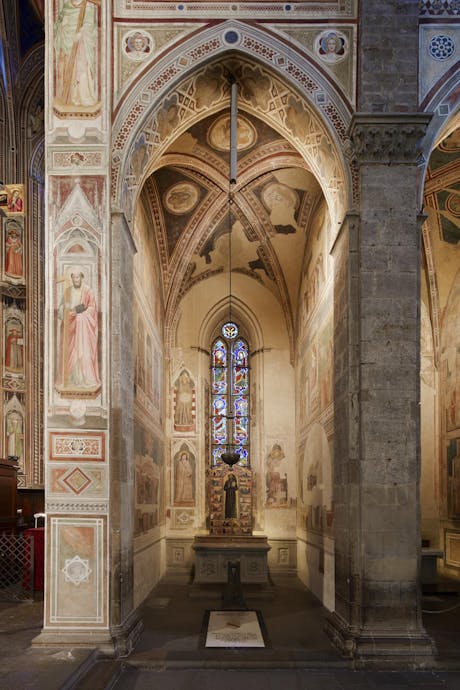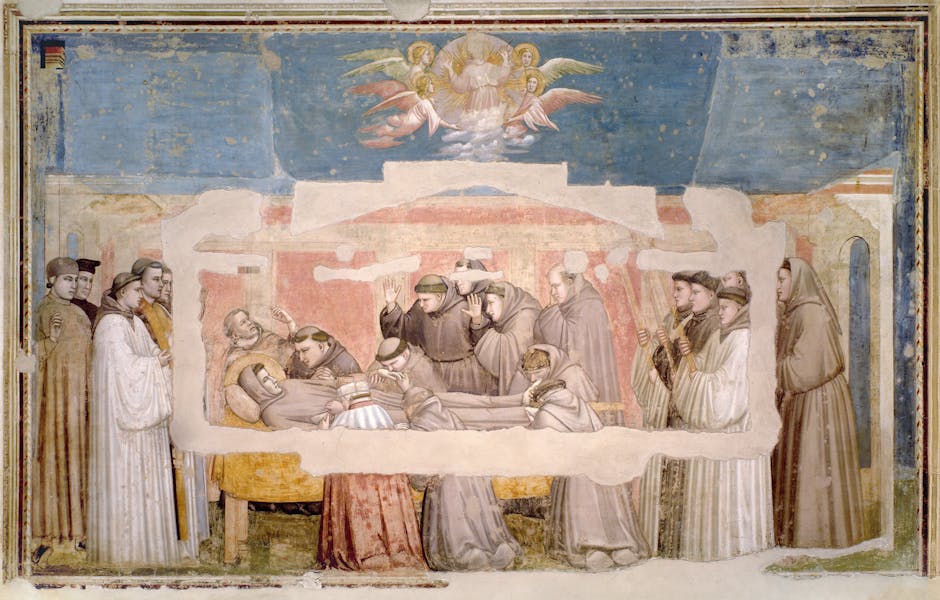
#Giving4Giotto
A call to arms to save our wondrous masterpiece of art from further decay!
This fundraising campaign is focused on conserving an extraordinary work of art executed by Giotto: the Stories of St. Francis frescoed in the early 14th century for the Bardi chapel in Santa Croce.
The restoration of the cycle of frescoes coming over sixty years after the last intervention, is a unique opportunity to rediscover the great communicative strength of Giotto and learn the secrets and technique of the artist within one of the greatest and most famous Franciscan basilicas in the world.
The works will involve the whole of the chapel and we have already started thanks to private funding and now we just need you, and your generosity to help to complete it; each and every contribution is precious and will help us to save this marvelous work of art, an authentic expression of the historical, cultural and spiritual legacy of Santa Croce.
Giotto in Santa Croce
Giotto, was a 14th century Florentine artist, considered the father of Italian painting who changed the history of art. One of his most iconic and world famous works is this magnificent cycle of frescoes.
Painted inside the Bardi chapel in Santa Croce, the Stories of the life of Saint Francis hold an enormous cultural, artistic and spiritual value that still today continue to be a magnet for thousands of visitors and academics.
Over time, Giotto's story has been enriched with myths and anecdotes that have lent him an almost legendary aura, to the point of even being mentioned by Dante in his XI canticle of Purgatory.
A highly sought-after artist, Giotto received commissions from all over Italy. It was therefore no surprise that the Bardi family, Florentine bankers, decided to entrust him with the task of decorating the Bardi chapel in Santa Croce.
The structure of the chapel
Giotto decided to represent the Stories of St. Francis which the artist had previously illustrated in the upper church in Assisi, in six episodes painted on the side walls of the Bardi chapel, three per wall, plus the scene of the Stigmatization of St. Francis over the arch above the entrance to the chapel.

The exterior of the Bardi chapel
Why restore the frescoes
In order to save one of the most loved and famous paintings in the world we must act very quickly- the Covid-19 pandemic has not helped. The works had to be postponed but we have now commenced.

Giotto, Death of St. Francis, whose soul is carried to heaven by angels; Doubting Sir Jerome views St. Francis's stigmata, scene from the Stories of St. Francis, 1317-1325. Basilica of Santa Croce, transept wall above the Bardi Chapel
The restoration
The restoration of the frescoes has been entrusted by the Opera di Santa Croce to the Opificio delle Pietre Dure, (OPD), the most prestigious restoration body in Italy, also considered an excellence throughout the world.
Initially, the OPD needed to study these pictorial cycles in depth to understand their real conditions and to be able to create a long-term conservation programme.
The Opificio delle Pietre Dure, developed an articulated research on the work of Giotto in the Bardi Chapels starting in 2009. Thanks to the intervention of the Getty Foundation in Los Angeles, an innovative diagnostic campaign of a technical-scientific nature was conducted extending the wide range of non-invasive, analytical investigations that constitute the standard for mural paintings.
The experts involved have studied in depth to understand the real conditions using the most advanced instruments, carried out in collaboration with various research institutes.
The restorations should have started in 2020 but, like many other projects, had to be postponed because of lockdown. Now however we are proud to say that this motivated and impressive project to restore Giotto’s work of art is a reality.
A precious help
In its commitment to this great project, the Opera di Santa Croce has been able to count on the full collaboration of the Opificio delle Pietre Dure (OPD) of Florence, which has put forward its expertise and resources for the project and has conducted, over recent years, an in-depth research on Giotto's work of art in the Bardi and Peruzzi Chapels.
In order to start the complex restoration scheduled to last about three years, the following contributions have been decisive:
- Fondazione CR Firenze – A foundation of banking origin, a non-profit organization that pursues social interest causes through a careful programme of investments and projects within their local territory, and that has always paid great attention to the promotion of culture and art and the conservation and enhancement of cultural heritage.
- A.R.P.A.I – Association for the Restoration of Italian Artistic Heritage, which works towards the protection of the Italian artistic heritage and which since 1989 has financed interventions on over three hundred works. With this project A.R.P.A.I has chosen to pay tribute to the memory of Countess Florence and Count Paolo Marzotto, founder and former president of the Association.
Both the Fondazione CR Firenze and ARPAI intervene through Art bonus, a tax bonus for those who support culture.
How to donate
The works will last at least three years. The restoration covers the entire chapel and is supported only thanks to the funds collected through visits and private donations. We invite you to take part in our fundraising campaign #Giving4Giotto: you will become part of a project of great historical importance for the safeguarding of this world legacy. Every contribution, even the smallest, is extremely precious.

